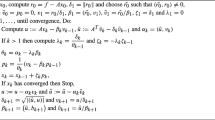Summary
There are many examples where non-orthogonality of a basis for Krylov subspace methods arises naturally. These methods usually require less storage or computational effort per iteration than methods using an orthonormal basis (optimal methods), but the convergence may be delayed. Truncated Krylov subspace methods and other examples of non-optimal methods have been shown to converge in many situations, often with small delay, but not in others. We explore the question of what is the effect of having a non-optimal basis. We prove certain identities for the relative residual gap, i.e., the relative difference between the residuals of the optimal and non-optimal methods. These identities and related bounds provide insight into when the delay is small and convergence is achieved. Further understanding is gained by using a general theory of superlinear convergence recently developed. Our analysis confirms the observed fact that in exact arithmetic the orthogonality of the basis is not important, only the need to maintain linear independence is. Numerical examples illustrate our theoretical results.
Similar content being viewed by others
References
Axelsson, O., Vassilevski, P.S.: Variable-step multilevel preconditioning methods. I. Self-adjoint and positive definite elliptic problems. Numer. Linear Algebra Appl. 1, 75–101 (1994)
Barrett, R. et al.: Templates for the Solution of Linear Systems: Building Blocks for Iterative Methods. SIAM, Philadelphia, 1994
Di Benedetto, F., Fiorentino, G., Serra, S.: C.G. preconditioning for Toeplitz matrices. Computers Math. Applic. 25, 35–45 (1993)
Chan, T.F., Chow, E., Saad, Y., Yeung, M.C.: Preserving symmetry in preconditioned Krylov subspace methods. SIAM J. Scientific Comput. 20, 568–581 (1998)
Cullum, J.: Peaks, plateaux, and numerical stabilities in a Galerkin/minimal residual pair of methods for solving Ax=b. Appl. Numer. Math. 19, 255–278 (1995)
Cullum, J.: Arnoldi versus nonsymmetric Lanczos algorithms for solving matrix eigenvalue problems. BIT 36, 470–493 (1996)
Cullum, J.: Iterative methods for solving Ax=b, GMRES/FOM versus QMR/BiCG. Advances Comput. Math. 6, 1–24 (1996)
Cullum, J., Greenbaum, A.: Relations between Galerkin and norm-minimizing iterative methods for solving linear systems. SIAM J. Matrix Anal. Appl. 17, 223–247 (1996)
Freund, R.W.: Conjugate Gradient-type methods for linear systems with complex symmetric coefficient matrices. SIAM J. Scientific Comput. 13, 425–448 (1992)
Freund, R.W., Nachtigal, N.M.: QMR: A quasi-minimal residual method for non-Hermitian linear systems. Numerische Mathematik 60, 315–339 (1991)
Golub, G.H., Van Loan, C.F.: Matrix Computations. The John Hopkins University Press, Baltimore, Third Edition, 1996
Golub, G.H., Ye, Q.: Inexact preconditioned conjugate gradient method with inner–outer iteration. SIAM J. Sci. Comput. 21, 1305–1320 (1999)
Greenbaum, A.: Iterative Methods for Solving Linear Systems. SIAM, Philadelphia, 1997
Greenbaum, A., Rozložník, M., Strakoš, Z.: Numerical Behaviour of the Modified Gram-Schmidt GMRES Implementation. BIT 37, 706–719 (1997)
Greenbaum, A., Strakoš, Z.: Predicting the behavior of finite precision Lanczos and conjugate gradient computations. SIAM J. Matrix Anal. Appl. 13, 121–137 (1992)
Gustafson, K.E., Rao, D.K.M.: Numerical Range: The Field of Values of Linear Operators and Matrices. Springer, New York, 1997
Higham, N.J.: The Matrix Computation Toolbox. Technical report, Manchester Centre for Computational Mathematics, 2002. In: www.ma.man.uc.uk/~higham/mctoolbox
Hochbruck, M., Lubich, C.: Error analysis of Krylov methods in a nutshell. SIAM J. Scientific Comput. 19, 695–701 (1998)
Lanczos, C.: Solution of linear equations by minimized iterations. J. Res. Natl. Bur. Stand. 49, 33–53 (1952)
Liesen, J., Rozložník, M., Strakoš, Z.: Least Squares Residuals and Minimal Residual Methods. SIAM J. Scientific Comput. 23, 1503–1525 (2003)
Liesen, J., Strakoš, Z.: Convergence of GMRES for tridiagonal Toeplitz matrices. SIAM J. Matrix Anal. Appl. 26, 233–251 (2004)
Liesen, J., Strakoš, Z.: GMRES convergence analysis for a convection-diffusion model problem. Technical Report 26-2003, Institute of Mathematics, Technical University of Berlin, 2003. To appear in SIAM J. Scientific Comput.
Morgan, R.: Implicitly restarted GMRES and Arnoldi methods for nonsymmetric systems of equations. SIAM J. Matrix Anal. Appl. 21, 1112–1135 (2000)
Notay, Y.: Flexible conjugate gradient. SIAM J. Scientific Comput. 22, 1444–1460 (2000)
Paige, C.C., Strakoš, Z.: Residual and Backward Error Bounds in Minimum Residual Krylov Subspace Methods. SIAM J. Scientific Comput. 23, 1899–1924 (2002)
Saad, Y.: Practical use of some Krylov subspace methods for solving indefinite and unsymmetric linear systems. SIAM J. Scientific Stat. Comput. 5, 203–228 (1984)
Saad, Y.: Iterative Methods for Sparse Linear Systems. The PWS Publishing Company, Boston, 1996. Second Edition, SIAM, Philadelphia, 2003
Saad, Y., Schultz, M.H.: GMRES: A Generalized Minimal Residual Algorithm for Solving Nonsymmetric Linear Systems. SIAM J. Scientific Stat. Comput. 7, 856–869 (1986)
Saad, Y., Wu, K.: DQGMRES: a direct quasi-minimal residual algorithm based on incomplete orthogonalization. Numerical Linear Algebra Appl. 3, 329–343 (1996)
Simoncini, V.: A matrix analysis of Arnoldi and Lanczos methods. Numer. Math. 81, 125–141 (1998)
Simoncini, V.: On the convergence of restarted Krylov subspace methods. SIAM J. Matrix Anal. Appl. 22, 430–452 (2000)
Simoncini, V., Szyld, D.B.: Theory of Inexact Krylov Subspace Methods and Applications to Scientific Computing. SIAM J. Scientific Comput. 25, 454–477 (2003)
Simoncini, V., Szyld, D.B.: On the Occurrence of Superlinear Convergence of Exact and Inexact Krylov Subspace Methods. SIAM Review, 47, 247–272 2005
van der Vorst, H.A.: Iterative Krylov Methods for Large Linear Systems. Cambridge University Press, Cambridge, 2003
van der Vorst, H.A., Melissen, J.B.M.: A Petrov-Galerkin type method for solving Ax=b, where A is symmetric complex. IEEE Trans. Magnetics 26, 706–708 (1990)
Author information
Authors and Affiliations
Corresponding author
Rights and permissions
About this article
Cite this article
Simoncini, V., Szyld, D. The effect of non-optimal bases on the convergence of Krylov subspace methods. Numer. Math. 100, 711–733 (2005). https://doi.org/10.1007/s00211-005-0603-8
Received:
Revised:
Published:
Issue Date:
DOI: https://doi.org/10.1007/s00211-005-0603-8




